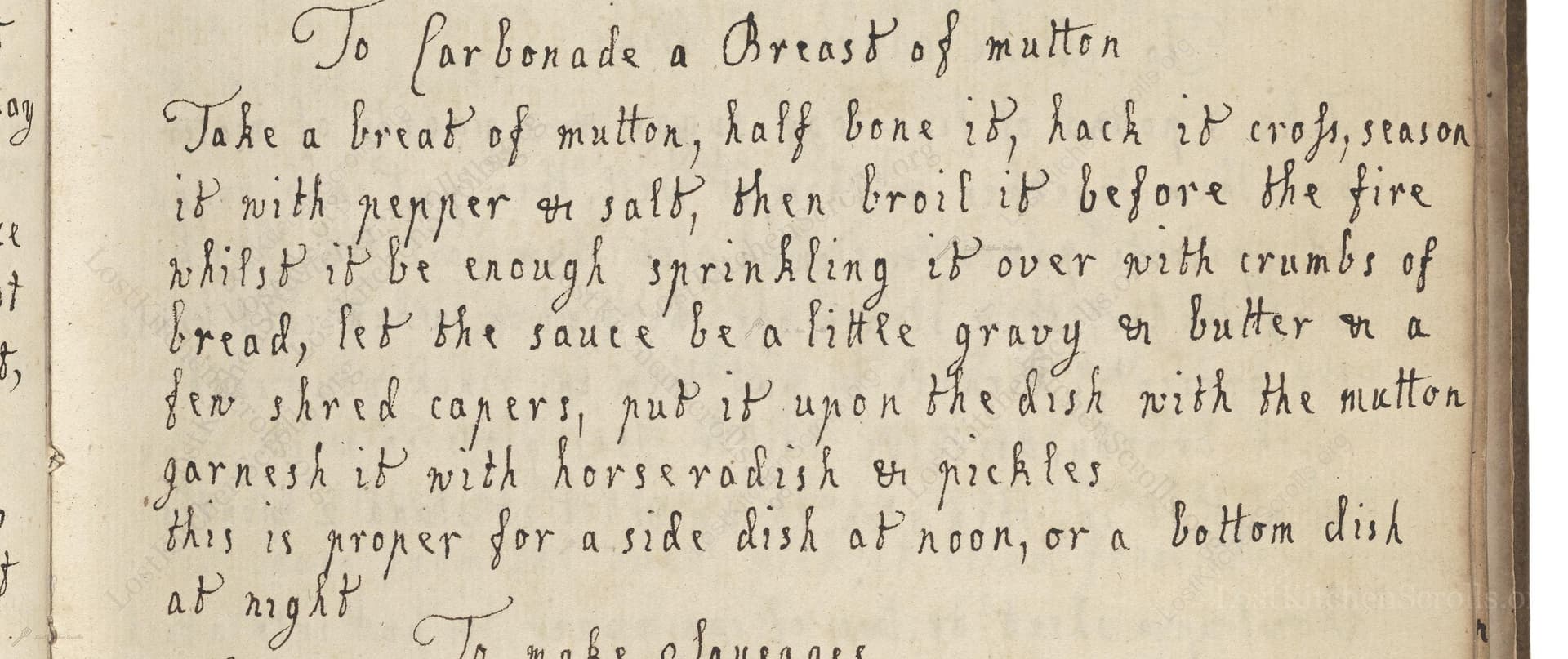To Carbonade A Breast Of Mutton
From the treasured pages of Cookbook of 1720
Unknown Author

To Carbonade A Breast Of Mutton
"Take a breast of mutton, half bone it, hack it cross, season it with pepper or salt, then broil it before the fire whilst it be enough sprinkling it over with crumbs of bread, let the sauce be a little gravy or butterr or a few shred capers, put it upon the dish with the mutton garnish it with horseradish & pickles this is proper for a side dish at noon, or a bottom dish at night"
Note on the Original Text
The recipe is written in the direct, almost conversational style typical of early modern English cookery books. Instructions prioritize key actions—like 'half bone it' or 'hack it cross'—assuming the reader's familiarity with basic butchery and fire cooking techniques. Spelling is relatively modernized for 1720, though terms like 'enough' (for 'until done') and 'proper' (suitable) are idiomatic for that era. Quantities are left vague since cooks adjusted to the size of the meat and their household needs—metric equivalents are modern chef interpretations.

Title
Cookbook of 1720 (1720)
You can also click the book image above to peruse the original tome
Writer
Unknown
Era
1720
Publisher
Unknown
Background
Step back to the early 18th century and discover a delightful treasury of recipes and culinary secrets, where traditional flavors meet timeless technique—a feast for curious cooks and history lovers alike.
Kindly made available by
Folger Shakespeare Library
This recipe dates from circa 1720, a time when meat cookery was central to English dining, especially within genteel households. 'Carbonading' referred to the process of scoring and grilling meats—often mutton or beef—directly before the fire, giving a slightly smoky, charred exterior. The inclusion of breadcrumbs reflects early 18th-century tastes for textural variety. Garnishes like horseradish and pickles not only added flavor but also acted as palate-cleansing agents, popular in both midday dinners (what we would now call lunch) and heavier evening suppers.

A large open-hearth or range fire with a sturdy gridiron for broiling formed the culinary heart of early 18th-century kitchens. Cooks would have used large meat knives to hack and score the mutton. Simple hand graters were used for horseradish, and pestles or small mortars might serve to shred capers. Sauce preparation relied on a small saucepan or a ladle placed at the hearth edge. Presentation involved large platters and plenty of small dishes for the garnishes.
Prep Time
20 mins
Cook Time
30 mins
Servings
4
We've done our best to adapt this historical recipe for modern kitchens, but some details may still need refinement. We warmly welcome feedback from fellow cooks and culinary historians — your insights support the entire community!
Ingredients
- 2–3 lb breast of mutton (or lamb breast as substitute)
- Salt, to taste
- Ground black pepper, to taste
- 1 oz fresh breadcrumbs
- 2 tbsp unsalted butter (or 3 tbsp rich meat gravy as alternative sauce)
- 1–2 tablespoons capers (shredded or chopped)
- Fresh horseradish, finely shredded (or prepared horseradish)
- Assorted pickles (cornichons, pickled onions, etc.)
Instructions
- Begin by taking a whole breast of mutton—about 2 to 3 pounds—and trim excess fat while leaving a modest layer for flavor.
- Carefully remove the larger rib bones, but leave enough to maintain structure.
- Score the flesh crosswise using a sharp knife.
- Generously season the mutton with salt and cracked black pepper on all sides.
- Preheat your grill or broiler to medium-high.
- Place the mutton, skin side up, under the heat and cook for about 15 minutes per side, or until nicely browned and just cooked through.
- During the final minutes of broiling, sprinkle a handful of fresh breadcrumbs over the meat to create a crisp, golden crust.
- For the sauce, melt 2 tablespoons of butter with 1–2 tablespoons of capers, or use a small ladle (about 3 tablespoons) of rich meat gravy.
- Slice the carbonaded mutton and serve on a platter, garnished with finely shredded horseradish and assorted pickles—such as cornichons or pickled onions.
- This dish makes for a robust centerpiece at lunch, or a substantial offering for a late supper.
Estimated Calories
450 per serving
Cooking Estimates
It takes about 15–20 minutes to prepare the mutton, and about 30 minutes to cook it under the grill or broiler. Each serving is hearty, about 450 calories per portion. The whole recipe serves 4 people.
As noted above, we have made our best effort to translate and adapt this historical recipe for modern kitchens, taking into account ingredients nowadays, cooking techniques, measurements, and so on. However, historical recipes often contain assumptions that require interpretation.
We'd love for anyone to help improve these adaptations. Community contributions are highly welcome. If you have suggestions, corrections, or cooking tips based on your experience with this recipe, please share them below.
Join the Discussion
Rate This Recipe

Den Bockfisch In Einer Fleisch Suppen Zu Kochen
This recipe hails from a German manuscript cookbook compiled in 1696, a time whe...

Die Grieß Nudlen Zumachen
This recipe comes from a rather mysterious manuscript cookbook, penned anonymous...

Ein Boudain
This recipe comes from an anonymous German-language manuscript cookbook from 169...

Ein Gesaltzen Citroni
This recipe, dating from 1696, comes from an extensive anonymous German cookbook...
Browse our complete collection of time-honored recipes



